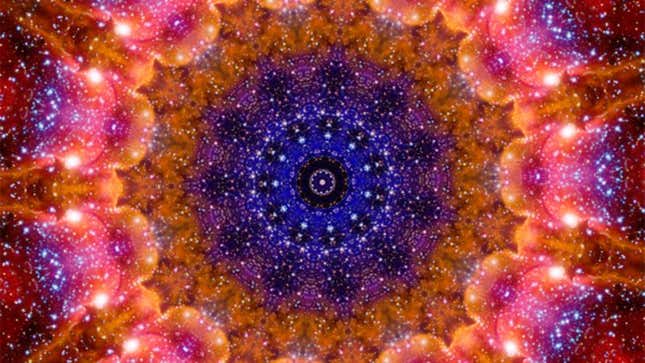
BALTIMORE—Astronomers analyzing the first images captured by the new Hubble Space Kaleidoscope, which went online Tuesday, announced that they've acquired the first concrete evidence that the universe is in a constant state of total weirdness.
"With their unprecedented resolution, the latest images from the new kaleidoscope reveal that space, once thought to be isotropic, is actually continuously expanding, unfolding, and rearranging in a series of freaky patterns," said astronomer Douglas Stetler, head of the Space Kaleidoscope Science Institute in Baltimore. "It's an exciting time for the field of astrokaleidoscopics, or anyone interested in the vast, wacked-out nature of space."

At $200 billion, the HSK, as scientists designate it, is the most expensive kaleidoscope ever built. Orbiting 300 miles above the Earth, the high-powered, 12-ton optical device has revealed unexpected discoveries at the farthest reaches of the universe, including a multitude of brilliantly colored interlocking and rotating diamond things never before observed by scientists.
HSK features three fine-guidance optical control sensors, a wide field and planetary camera, a faint object spectrograph, and three primary rectangular plane mirrors inside a rotating 30-meter titanium tube. The object chamber, located on the end that gathers and focuses incoming light from the visible part of the electromagnetic spectrum as well as the infrared and ultraviolet continua, is filled with 10,000 pounds of marbles, costume jewelry, beads, and the largest bits of colored glass ever produced.
"This new data will forever change how we look at the cosmos," said Stetler, who admitted he was "amazed" to learn that all galaxies rotate in a counterclockwise direction and never look the same way twice. "Before this, we couldn't even see the Lagoon Nebula, but now we are capable of detecting up to 254 constantly changing fractal versions of it at once. The further we probe the depths of space, the better we might understand just how vastly bonkers it looks."
Construction of the Hubble Space Kaleidoscope involved incredible technical challenges. According to NASA head engineer Nathan Howard, assembling components for the object chamber was particularly exacting, since it was necessary to create baubles that would still remain pretty despite the harsh environment of space. The project also faced controversy over fears that the device would be unable to record the continuously changing symmetrical forms of solar masses, after early calculations predicted that the $898 million in trinkets would not tumble properly in a zero-gravity environment.
"Despite those setbacks, the project is an unqualified success," Howard said. "The completed Hubble Kaleidoscope allows researchers to view the sharpest, most refracted displays of light, color, and shape to date."
Looking at a kaleidoscopic image of a dwarf star, Howard added, "Oooooo!"
Unlike the Hubble Telescope, which has allowed astronomers to view remote objects millions of light years away, the orbital kaleidoscopic observatory has taken humankind's knowledge of the cosmos one step further: Scientists now have access to clear images of the multicolored polygons and sparkling glitter now believed to cover up to 99.999 percent of the known universe.
The new data have challenged nearly every assumption about astrophysical phenomena.
"When we trained the powerful kaleidoscope lens on the massive eye of Jupiter, we expected to see a swirling behemoth of red and orange gas," said Dr. Mae Ling-Turlington, who works at the observatory. "What we found instead was a dazzling hexagonal array of variegated prismatic configurations, changing our very understanding of the atmospheric patterns there on the solar system's spikiest-looking planet."
Their findings are so startling, in fact, that kaleidoscopists are calling for standard models of the structure of the universe to be revamped. According to the new data, the so-called asteroid "belt" is actually an asteroid squiggle; and Mars is only red "some of the time," vacillating between purplish-blue, orange, and turquoise with specks of green as it moves along its six separate orbits around the sun.
Despite excitement over the discovery that space is all crazy-looking, a number of legislators have threatened to cut funding for NASA's kaleidoscopic program. An outspoken critic of the agency, Sen. Susan Collins (R-ME) said she hopes NASA scientists don't just use the kaleidoscope a few times and then lose interest and never touch it again, like they did with the Brookhaven Neutrino Spirograph, Fermilab's Particle Slingshot, and the Very Large Slip 'n Slide Array in New Mexico.